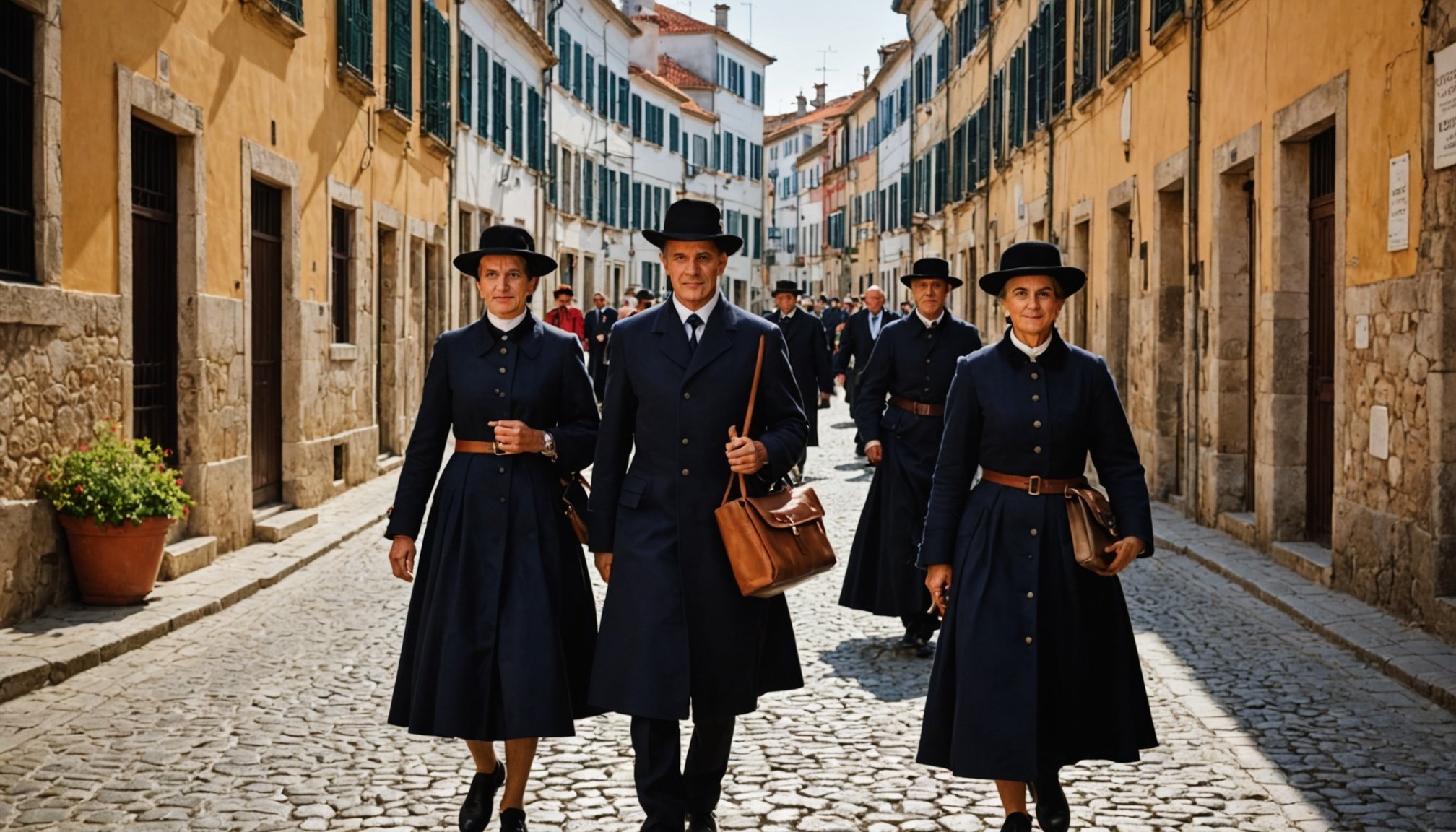Explore the Enchanting Culture and Beauty Across Portugal’s Regions
If you’re planning to visit Portugal, you’re in for a treat. This country is a treasure trove of rich history, vibrant culture, and stunning natural beauty. To get the most out of your trip, it’s essential to understand the diverse regions that make Portugal so unique. Here’s a detailed guide to help you explore the best of Portugal’s regions.
The Cultural Heart of Portugal: Music and Dance
Portugal’s culture is deeply rooted in its music and dance, which are integral parts of the country’s heritage.
In parallel : Creating an Impactful Customer Service Training Strategy for Call Centers in Sheffield
The Soul of Portugal: Fado
Fado, often described as the “soul of Portugal,” is a genre of music characterized by melancholic melodies and poetic lyrics. It explores themes of nostalgia, love, and sorrow. The houses of fado in cities like Lisbon and Porto are popular gathering places where you can experience live performances. Amália Rodrigues, known as the “Queen of Fado,” played a significant role in popularizing this genre globally.
There are two main styles of fado: the fado de Lisbonne, which is more melancholic and introspective, and the fado de Coimbra, historically performed by students and characterized by a more optimistic tone. Both styles share a common heart filled with saudade, a sentiment of nostalgia and melancholy dear to the Portuguese soul1.
Topic to read : Discover portugal's seven regions: culture, history, and beauty
Folk Dances
Folk dances are another important expression of Portuguese culture. These dances, often accompanied by accordions and drums, are a common sight during festivals and celebrations.
Dances like the vira, corridinho, and fandango reflect the regional diversity of Portugal. The vira, originating from the Minho region, is particularly dynamic and joyful, while the corridinho from the Algarve region features rapid movements and an engaging rhythm. The fandango, prevalent in the Ribatejo region, is distinguished by its complexity and elegance. These dances are not just entertainments but also manifestations of the cultural and historical identity of different regions, passed down through generations and celebrating life, love, and community1.
Historic and Architectural Treasures
Portugal’s rich and complex history is vividly reflected in its varied architecture.
Manueline Style
The Manueline style, an emblem of Portuguese architecture, emerged in the 16th century. It combines Gothic, Renaissance, and Mozarabic elements, symbolizing the era of Portugal’s great maritime discoveries.
The Monastery of the Hieronymites in Lisbon and the Tower of Belém are masterpieces of this style. The Convent of Christ in Tomar, famous for its Manueline window, shows a remarkable fusion of architectural influences. These structures, with their references to maritime discoveries, are testaments to Portugal’s golden age1.
Azulejos and Artisan Crafts
Azulejos, or ceramic tiles, are another distinctive element of Portuguese architecture. Used both as decorative and functional elements, they are ubiquitous throughout the country.
Portuguese craftsmanship is a mosaic of colors, textures, and traditions. Each piece tells a story, each thread reveals a distant past, passed down through generations. The tapestries of Arraiolos, the lace of Bilros, and the pottery of the Alentejo are just a few examples of the rich artisanal heritage. Each region has its unique crafts, such as the filigrana jewelry in the north, which is a symbol of exceptional craftsmanship1.
Gastronomic Delights
Portuguese gastronomy is a cornerstone of the country’s culture, offering a variety of dishes that reflect the influence of the sea and different regions.
Seafood and Traditional Dishes
Being a coastal country, Portugal is famous for its seafood and fish dishes. Cataplana and bacalhau (cod) are staples of Portuguese cuisine.
Pastries, especially the pastéis de nata, are highly appreciated. These small custard tarts are an example of the influence of monasteries and convents on Portuguese pastry-making.
Regional Culinary Richness
Beyond the famous cod dishes and pastéis de nata, Portuguese cuisine is incredibly diverse. Each region boasts its own unique flavors, featuring artisanal charcuteries, cheeses, meats, and breads. The Algarve region is known for its seafood, while the Douro Valley is famous for its port wine. The country is also a land of exceptional wines, from the Douro Valley to the islands of Madeira, each telling a story of diverse terroirs and expertise passed through generations1.
Lusophone Heritage
The concept of Lusophonie encompasses the nations and peoples speaking Portuguese, representing a rich cultural, historical, and social fabric spanning several continents.
Historical and Cultural Roots
Lusophonie finds its roots in Portugal’s history as a maritime pioneer in the 15th-century explorations. These voyages extended the geographical reach of the Portuguese language and created lasting cultural links with various regions of the world.
The Portuguese colonial expansion played a crucial role in the dissemination of the language and culture. Countries like Brazil, Angola, Mozambique, Macau, and East Timor integrated these influences, creating a unique cultural mix.
Modern Lusophonie
Modern Lusophonie is characterized by cultural diversity. Each Lusophone country has developed its own cultural identity while sharing linguistic and historical ties with Portugal. The Portuguese language serves as a unifying link within Lusophonie, facilitating cultural and economic exchanges. Institutions like the Community of Portuguese Language Countries (CPLP) play a crucial role in promoting Lusophone culture and language, strengthening ties between member countries1.
Regional Highlights
Lisbon: The Historic Heart
Lisbon, the capital, is a city steeped in rich history and heritage. Its historic center, with its cobbled streets and panoramic views, is a must-visit. The city is home to the Belem Tower, a UNESCO World Heritage site, and the Monastery of the Hieronymites, showcasing the Manueline style.
Porto: The City of Port Wine
Porto, known for its port wine, is a city that blends tradition with modernity. The Douro River runs through the city, offering stunning views. The Ribeira district, with its colorful buildings and lively atmosphere, is perfect for a stroll. Don’t miss the São Francisco Church and the Clérigos Tower for their architectural beauty and historic significance.
Algarve Region: Beaches and Natural Beauty
The Algarve region in southern Portugal is renowned for its beaches and natural beauty. The Atlantic Ocean coastline offers a variety of beaches, from the bustling Praia da Rocha to the secluded Praia da Amarela. The region is also home to the Ria Formosa Natural Park, a protected area with diverse wildlife and ecosystems.
Douro Valley: A World Heritage Site
The Douro Valley, another UNESCO World Heritage site, is famous for its vineyards and port wine production. The valley offers panoramic views of the Douro River and surrounding landscapes. It’s the perfect place to visit wineries and enjoy a wine tasting tour.
Best Time to Visit
The best time to visit Portugal depends on your preferences. Spring (March to May) and autumn (September to November) are ideal for exploring the cities and regions without the peak summer heat. Summer is perfect for enjoying the beaches of the Algarve, while winter is a good time to explore the cities and indoor attractions without the crowds.
Practical Tips for Travelers
- Getting Around: Portugal has a well-connected public transportation system. Trains and buses are efficient ways to travel between cities.
- Accommodation: From budget-friendly hostels to luxury hotels, Portugal offers a wide range of accommodation options.
- Food: Be sure to try the local cuisine, including seafood, traditional dishes, and pastries.
- Language: While many Portuguese speak English, learning a few basic Portuguese phrases can go a long way in enhancing your experience.
- Safety: Portugal is generally a safe country, but take normal precautions to protect yourself and your belongings.
Portugal is a country that offers something for everyone. Whether you’re interested in historic sites, natural beauty, gastronomy, or cultural heritage, each region of Portugal has its unique charm. So, pack your bags, and get ready to explore the enchanting culture and beauty across Portugal’s regions.
For a more detailed guide on Portugal’s seven regions, culture, history, and beauty, you can visit Discover Portugal’s Seven Regions: Culture, History, and Beauty.
Table: Comparing Key Regions of Portugal
| Region | Key Attractions | Must-Try Foods | Best Time to Visit |
|---|---|---|---|
| Lisbon | Historic Center, Belem Tower, Monastery of the Hieronymites | Pastéis de Nata, Bacalhau | Spring, Autumn |
| Porto | Ribeira District, São Francisco Church, Clérigos Tower | Port Wine, Francesinha | Spring, Autumn |
| Algarve | Praia da Rocha, Praia da Amarela, Ria Formosa Natural Park | Seafood, Cataplana | Summer |
| Douro Valley | Vineyards, Panoramic Views of the Douro River | Port Wine, Local Cheeses | Spring, Autumn |
| Minho | Guimarães Castle, Braga Historic Center | Broa de Milho, Caldo Verde | Spring, Autumn |
| Alentejo | Évora Historic Center, Arraiolos Tapestries | Pork with Clams, Bread from Alentejo | Spring, Autumn |
| Trás-os-Montes | Chaves, Barroso, Pão de Centeio | Smoked Meats, Goat Cheese | Spring, Autumn |
Detailed List: Must-Visit Places in Portugal
-
Lisbon:
-
Belem Tower: A UNESCO World Heritage site and symbol of Lisbon.
-
Monastery of the Hieronymites: A masterpiece of Manueline architecture.
-
Castelo de São Jorge: A historic castle offering panoramic views of the city.
-
Alfama Neighborhood: Known for its narrow streets, Fado music, and historic charm.
-
Porto:
-
Ribeira District: A colorful and lively area along the Douro River.
-
São Francisco Church: A Gothic church known for its intricate stone carvings.
-
Clérigos Tower: Offers stunning views of the city.
-
Port Wine Cellars: Visit wineries to taste some of the world’s best port wines.
-
Algarve:
-
Praia da Rocha: A popular beach town with golden sands and rock formations.
-
Praia da Amarela: A secluded beach known for its natural beauty.
-
Ria Formosa Natural Park: A protected area with diverse wildlife and ecosystems.
-
Lagos Historic Center: A charming town with historic buildings and a picturesque marina.
-
Douro Valley:
-
Vineyards: Visit wineries and enjoy wine tastings.
-
Panoramic Views: Take in the stunning views of the Douro River and surrounding landscapes.
-
Peso da Régua: A town known for its wine production and scenic views.
-
Lamego: Famous for its baroque church and historic center.
-
Minho:
-
Guimarães Castle: A medieval castle and birthplace of Portugal.
-
Braga Historic Center: Known for its Roman ruins and baroque architecture.
-
Peneda-Gerês National Park: A natural park with diverse flora and fauna.
-
Vila Nova de Gaia: A town famous for its broa de Avintes and festive atmosphere.
-
Alentejo:
-
Évora Historic Center: A UNESCO World Heritage site with Roman ruins and medieval architecture.
-
Arraiolos Tapestries: Famous for its handmade tapestries.
-
Mértola: A historic town with a mix of Moorish and Christian influences.
-
Sagres Fortress: A fort at the southwestern tip of Europe.
-
Trás-os-Montes:
-
Chaves: A town known for its Roman bridge and thermal baths.
-
Barroso: Famous for its smoked meats and traditional bread.
-
Pão de Centeio: Try the local rye bread, a specialty of the region.
-
Montesinho Natural Park: A protected area with diverse wildlife and ecosystems.
Each region of Portugal offers a unique blend of history, culture, and natural beauty, making it a destination that has something for every kind of traveler. Whether you’re interested in exploring historic sites, enjoying the local cuisine, or simply taking in the panoramic views, Portugal is a country that will enchant and inspire you.











